What is a decarbonized (carbon neutral) society and future energy in Japan? A veteran engineer explain in an easy-to-understand manner!

Is hydrogen the energy of the future!? What is a carbon neutral society?
What is a carbon-neutral society?
Ms. Hama: Mr. Hashimoto! Few days ago, I saw a car running with hydrogen on TV!
Hydrogen is said to be an environmentally friendly energy that considers the future. I'd like to know how it works and why it is used!
Mr. Hashimoto: That's a fuel cell vehicle (FCV) using hydrogen. It is an electric car that generates electricity by the chemical reaction of hydrogen and oxygen, and turns the motor with the electricity.
This technology has also been applied in trucks and buses, and has expanding its practical use. Recently, it has got into the news that hydrogen engine cars running on hydrogen itself instead of gasoline ran in an endurance race.
There are many difficulties, but it is also studied to generate electricity by turning turbines with hydrogen. Hydrogen is one of a new options for "carbon-free energy."

Ms. Hama: I see. Hydrogen energy is expected to be used in a wide range of fields such as power generation, transportation, and industry. Why has electric vehicles (EV: Electric Vehicles) and fuel cell vehicles (FCVs) suddenly got public attention?
Mr. Hashimoto: That's a good question. It has a lot to do with carbon-neutral society and Japan's energy problems. One of the problems we're facing is the global warming. Its cause is greenhouse gases, mainly carbon dioxide (CO2). Once the gases released into the atmosphere, CO2 remains semi-permanently there unless it is absorbed by plants and oceans.
Remaining CO2 has an extremely large impact on global warming.
It is considered as the cause of the global abnormal weather. In order to maintain the global environment, it is necessary to realize a carbon-neutral society that reduces greenhouse gas (CO2) as much as possible.
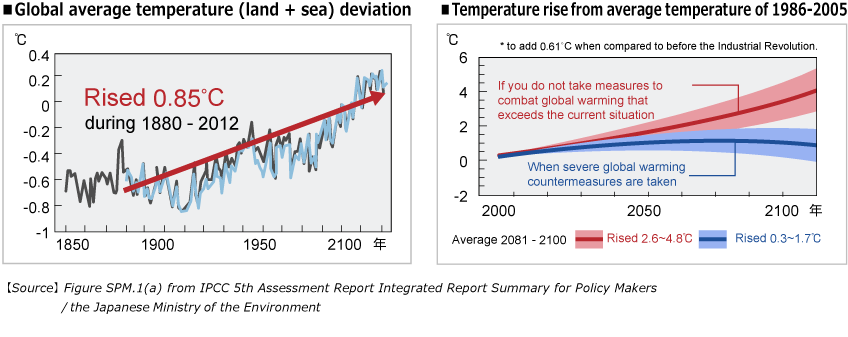
Ms. Hama: It is the Japanese government's announce. "By 2050, we aim to realize a carbon-neutral, decarbonized society that reduces greenhouse gas emissions to zero as a whole." Carbon neutrality means to offset greenhouse gas emissions and absorption to zero.
Mr. Hashimoto: That's right. You've studied well. 125 countries and one region have announced carbon neutrality By 2050. Japan is lagging behind the world, and this declaration will lead to a shift in the industrial structure and reduction of emissions. Decarbonization has already become an important theme for industry.
What like the future energy?
What is Japan's energy policy?
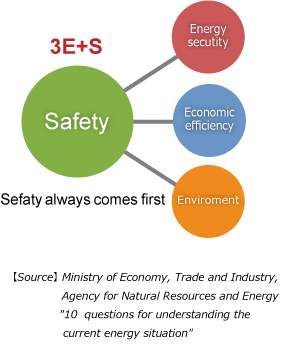
Mr. Hashimoto: Energy policy is a very important theme for Japan, where there are few energy resources. The government's policy includes energy strategy plans, and the sixth plan will be issued this year (2021).
The previous 5th plan has '3E' basic principles. Energy security (Exceed the self-sufficiency level to approx. 25% by FY 2030),
Economic Efficiency (Reduce costs to 9.2~9.5 trillion yen by FY 2030), Environment suitability (Achieve targets for reduction in greenhouse gases. 26% reduction from FY 2013 levels by FY 2030). In 2014, after the Great East Japan
Earthquake, Safety (Safety always comes first)was added to
these principles, and it became "3E+S", which aims to realize 3E
while prioritizing safety.
Energy mix for 2030
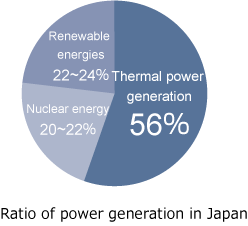
Mr. Hashimoto: The 5th Basic Energy Plan sets the goals of 'to reduce emission of greenhouse gases
by 26%' and 'to surely achieve energy mix target'
Energy mix is needed because there's no perfect power generation method.
In order to compensate for each problem, it is necessary to use various power generation methods in a balanced manner, and to take medium-to-long-term action.
Ms. Hama: In Japan, thermal power generation still has been used mainly, hasn't it? The energy mix is likely to become important to reduce CO2 emission.
Mr. Hashimoto: That's right. In addition, among thermal power generation, the development of technology to reduce CO2 emissions of liquefied natural gas is progressing. Power generation that does not emit CO2 with hydrogen gas and ammonia has also been studied. I summarized each power generation method in a table.
| Power generation method | Power configuration | Stable supply of energy | Environmental conservation | Driving characteristics | ||
|---|---|---|---|---|---|---|
| 2018 | 2030 | CO2 emissions(g-CO2/kWh) | ||||
| About 1,512 billion kWh | About 1,650 billion kWh | During mining, construction and transportation | At the time of power generation | |||
| Coal (thermal power) | 32% | 26% | •Fuel reserves are widely distributed around the world |
■79 | ■■■■■864 | •Gentle output variation is possible •Easy to adjust the output in response to demand |
| Oil (thermal power) | 7% | 3% | •Fuel reserves are biased distrubution in the Middle East | ■43 | ■■■■695 | |
| Natural gas (thermal power) | 38% | 27% | •Low bias in fuel reserve areas | ■123 | ■■■476 | •Possible to adjust the output in response to demand |
| Nuclear energy | 6% | 20~22% | •It's excellent in storability •The fuel is recycable |
19 | No CO2 emissions during power generation |
•Output is always constant |
| Sunlight | 6% | 7% | •There is no risk of resource depletion •Be influenced by natural conditions |
■38 | •Output varies greatly depending on the natural conditions | |
| Wind power | 0.70% | 1.70% | 26 | |||
| Hydraulic power | 7.70% | 8.8~9.2% | _ | 11 | •Output is almost constant | |
| Biomass | 2.20% | 3.7~4.6% | _ | _ | _ | |
| Geothermal | 0.20% | 1.0~1.1% | _ | _ | _ | |
| Ammonia | _ | _ | _ | _ | •Output is almost constant | |
Ms. Hama: I see that every power generation method has its advantages and disadvantages.
Mr. Hashimoto: Next, I summarized renewable energies. Although it is regarded as an energy that does not emit CO2, there are also issues such as the stability of power supply and the high cost of installing equipment. Miki Pulley products such as couplings and brakes are also used in the equipment
| Variety | Summary | Feature | System |
|---|---|---|---|
| Sunlight | A system that directly converts the light energy of the sun into electricity. Expanded the introduction from home use to large-scale power generation. | ・No fuel charge required ・No emission of CO2 ・Vast area is required ・ The amount of sunshine changes, the night power generation is not possible | 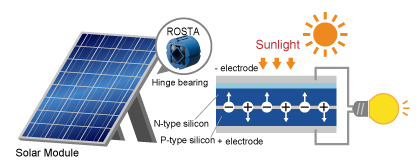 Products used: shock absorbing, shaking, anti-vibration equipment (ROSTA) Products used: shock absorbing, shaking, anti-vibration equipment (ROSTA) |
| Wind power | Turn the windmill and transmit the rotational motion to the generator to produce electricity. There are land and offshore installations. | ・ No limit to the wind power ・ No emission of CO2 ・ The amount of power generated is unstable. It changes depending on season, time ・ Noise from turbine blade |
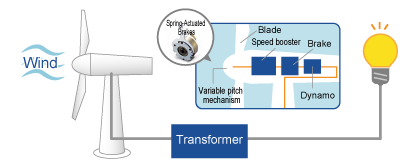 Products used: Spring-Actuated brakes Products used: Spring-Actuated brakes |
| Hydraulic power | By utilizing the difference in the height of rivers, to have water drop and water mills are turned to generate electricity. There are also small and medium-sized types that can generate electricity even in agricultural water and water supply facilities. | ・ Stable long-term operation is possible ・ For Small and medium-sized types, there are demand as distributed power generation. (relatively high cost) |
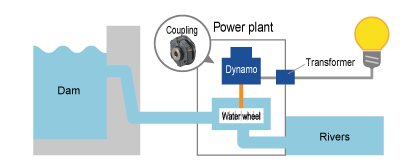 Products used: Rubber and resin couplings for motor vehicles (CENTAFLEX) Products used: Rubber and resin couplings for motor vehicles (CENTAFLEX) |
| Geothermal | Geothermal energy is extracted by steam and hot water, and turbines are turned to generate power. Abundant resources in volcanic countries. | ・Stable output, large-scale development is possible ・24-hour operation ・Development period about 10 years, it cost relatively higher ・Coordination with local people's interest is necessary (overlap with hot springs and park facilities) |
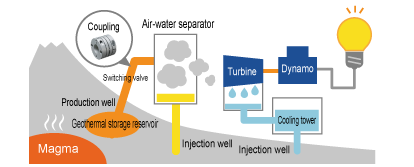 Products used: Metal disc couplings(SERVOFLEX) Products used: Metal disc couplings(SERVOFLEX) |
| Biomass | Electricity is generated utilizing the creature resources such as the animals and plants. Various resources including wooden biomas or the food waste convert into energy. | ・ Contributing to the reduction of waste ・ Not affected by the weather ・ Cost for stable supply of raw material(collecton,transportation, and management) is high |
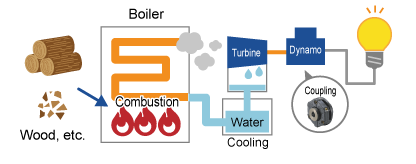 Products used: Products used: Rubber and resin couplings for motor vehicles (CENTAFLEX) Products used: Products used: Rubber and resin couplings for motor vehicles (CENTAFLEX) |
Energy saving Initiatives
What is Japan's energy-saving strategies?
Mr. Hashimoto: When you think about energy, you need to think about energy conservation that does not waste energy. Japan plans to thoroughly conserve energy in order to realize its demand & supply forecast for FY2030.
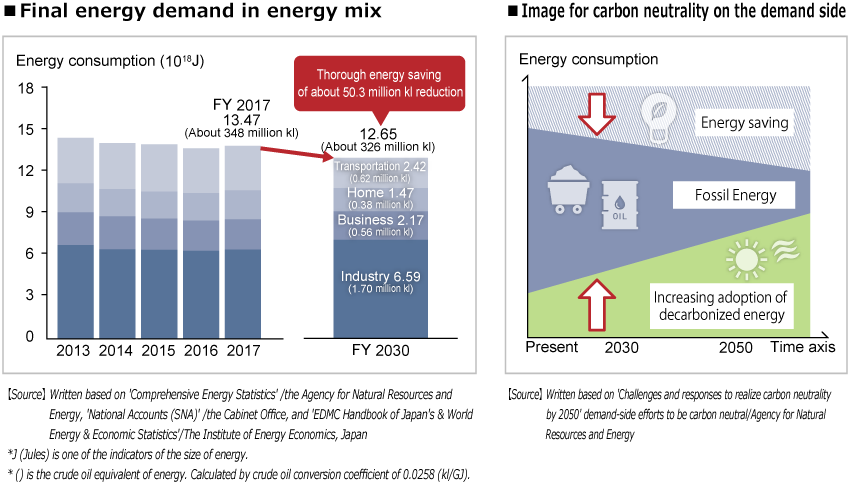
Ms. Hama: That's a very tough number. In order to achieve this goal, further energy-saving measures are necessary in industry, business, transportation, and home.
Mr. Hashimoto: That's right! Specific measures will be introduced below.
If the motor efficiency improves by 1%, it is possible to save electricity for one power plant of 500,000 kW! ?
Mr. Hashimoto: It is said that about half of the electric energy on earth is used by motors such as robots, factory equipment, refrigerators, and air conditioners.
Since it is said that increasing the efficiency of the motor by 1% will lead to energy saving of 500,000 kW (power for one medium-sized nuclear power plant), it is necessary to correctly select couplings and clutch brakes, which are components used for power transmission, considering improving the efficiency of the motor.

Ms. Hama: It's surprising that the selection of couplings and clutch brakes effect on energy savings!

Initiatives in industry
Mr. Hashimoto: It is said that from now on, factories must thoroughly work on energy saving of air conditioning equipment and motors. Here are the details of the initiative.
■Machine tools
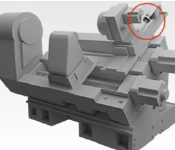
The processing accuracy of the workpieces greatly affected by the surrounding temperature change, heat generation from the machine, and heat generation in processing. Therefore, controlling the room temperature is critical and a lot of electrical energy is required.
[Energy saving]
To achieve this in an ordinary factory environment, we control thermal displacement.
Reduction of cutting fluid consumption, etc.
■Pumps, compressors, blowers
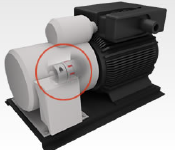
Electric motors are used in air conditioner, pumps and compressors in factories, and their power consumption is said to be about 50% of the total, and it is believed that working on energy saving of electric motors will lead to major power savings.
[Energy saving correspondence]
Improvement of energy consumption efficiency by The Top Runner Program.
By replacing old motors with a PM motor using a permanent magnet, energy saving and high efficiency are promoted.
Ms. Hama: Now I understood how seriously the industries have been making effort to save energy.
Mr. Hashimoto: Miki Pulley is also working on energy conservation, such as installing equipments to reuse the energy of testing machines.
Things we can do
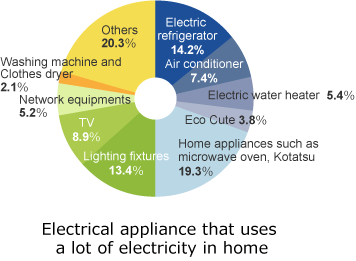
Ms. Hama: We found that carbon neutrality and energy issues are important themes for industry. Is there anything we can do in our daily lives?
Mr. Hashimoto: Of course, there is. Let's take a look at the graph on the right. It's electric refrigerators, air conditioners, and lighting fixtures that use a lot of electricity. By changing these home appliances to energy-saving type to reduce electricity consumption, you can contribute to carbon neutrality.
Ms. Hama: There's a lot we can do right away.
I’d like to start from what we can do, such as learning the correct selection method for couplings and clutch brakes, and reducing the amount of electricity waste!


Mr. Hashimoto, Miki Pulley Co., Ltd
Joined Miki Pulley in 1972. Worked as a Product Manager in the Marketing and Technology divisions in positions both in Japan and overseas. He has also been involved with other organizations through joint research projects with universities and specialist bodies. He currently works as technical adviser and staff trainer.

 日本語
日本語 English
English Deutsch
Deutsch 中文
中文 한국어
한국어





